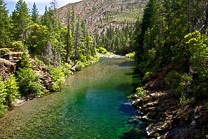In the last post flows were hovering around high and we were sneaking in surveys wherever we could as this year’s coho wrapped up their lifecycle. By the end of February we had finished up one last journey through the survey frame to finish out this year’s spawning ground surveys. I think maybe one or two coho were spotted in that last round, but by then all of the redds bore the distinctive marks of steelhead redds; deep potted and energetically built, but unfocused and ultimately kind of small. Since steelhead don’t die after they spawn, their strategy for redd building is entirely different than that of the salmon. A salmon will carefully work the gravel for a week or more, continually building and perfecting her one final masterpiece. On the other hand a steelhead is there to get it done quick and move on before getting caught. Like a mountaineer standing on some high summit, they’re only half way done.
So our season is done, and mill creek is slowly emptying of fish. But the creek is never really empty is it? The steelhead are starting to wrap up, pacific lamprey are just getting started, and the juvenile salmon are beginning to hatch. We’ve reached the flip side of all those carcasses and death of the spawning season, and the chinook eggs are beginning to hatch out as alevins, darting around through the spaces in the gravel. By now many of them have even developed into fry; fully formed little fishes that swim up into the turbulent world of the open creek, swirling around in eddies and generally being pushed downstream. The stream insects who’s population was boosted by all those salmon carcasses now go to feed the swarms of juveniles, and the cycle moves steadily forward. Meanwhile the survey crew moves forward with our own cycle. One rainy day in early March a crew gathered down in the mainstem of mill creek to install our downstream migrant trap. Every day this spring crews will go down and check the trap, counting and identifying all those little fish.
Ultimately as far as population numbers go this year they seem to be low, but somewhat similar to the past couple of years for both chinook and coho. While it is good that the population doesn’t seem to be in free fall, part of that is because if it fell much further it would be gone entirely. Since these populations are already on such tight margins any future management decisions that could impact these animals needs to be considered very seriously. Unfortunately as it currently stands, the future of this project is very much in doubt. Once again our funding did not go through, so although the cycle of the Smith River salmon continues on for now, the cycle of monitoring may not.
Some folks will say, “look, I know fish are cool but times are tough all around. Here we are spending all this money on monitoring some fish when we’ve got real problems of our own to deal with. What’s really going to happen if coho go extinct, we don’t really need coho do we?” And I can see this point of view, but I also know that it isn’t really just about coho. Old time coal miners didn’t need a canary to mine coal, but if that bird dropped dead it meant it was time to get out of that mine fast. As of yet we can’t really get off of this planet, so when we start seeing extinctions happening at a rate that’s only been matched five times before in the history of life on earth, we’d better start trying to figure out why all our “canaries” are dropping dead, and what that might mean for our own future.


